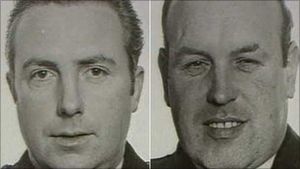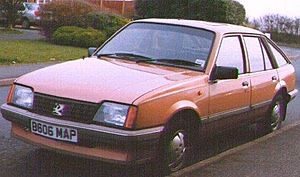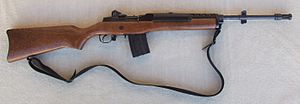1989 Jonesborough ambush facts for kids
Quick facts for kids 1989 Jonesborough ambush |
|
|---|---|
| Part of The Troubles | |

Warrant card photographs of Chief Superintendent Harry Breen (left) and Superintendent Bob Buchanan (right)
|
|
| Location | Edenappa Road, outside Jonesborough, County Armagh, Northern Ireland |
| Coordinates | 54°4′25.18″N 6°22′26.38″W / 54.0736611°N 6.3739944°W |
| Date | 20 March 1989 15:40 (UTC) |
|
Attack type
|
Shooting |
| Weapons | (2) .223 Armalite rifles, (1) Ruger Mini-14, (1) 7.62 Short rifle |
| Deaths | Chief Superintendent Harry Breen and Superintendent Bob Buchanan of the Royal Ulster Constabulary |
| Perpetrator | 1st Battalion Provisional IRA South Armagh Brigade |
The Jonesborough ambush happened on 20 March 1989. It took place near the border between Ireland and the United Kingdom. This event occurred close to the village of Jonesborough, County Armagh, in Northern Ireland. Two senior police officers from the Royal Ulster Constabulary (RUC) were killed. They were Chief Superintendent Harry Breen and Superintendent Bob Buchanan.
The officers were shot by members of the Provisional IRA South Armagh Brigade. Breen and Buchanan were driving back from a meeting. They had met with police officers from the Garda (Irish police) in Dundalk. The IRA gunmen stopped their car and opened fire. This event was a very sad moment during a period known as the Troubles.
After the ambush, no one was ever charged with the killings. However, there were ideas that some Irish police might have helped the IRA. This idea is called "collusion." Because of these ideas, a judge named Peter Cory looked into the killings in 2003. His findings led the Irish government to start a special investigation. This investigation was called the Smithwick Tribunal. It began in 2011 and finished in 2013. The report said it was likely that someone inside the Dundalk Garda station gave information to the IRA. This information was about Breen and Buchanan being there.
Contents
What happened before the ambush?
On the afternoon of Monday, 20 March 1989, two high-ranking RUC officers were returning from a meeting. Chief Superintendent Harry Breen, aged 51, and Superintendent Bob Buchanan, aged 55, had been in Dundalk, County Louth, in the Republic of Ireland. They had met with senior Garda officers. Buchanan had arranged this meeting by phone that morning.
The meeting started around 2:10 p.m. They discussed plans for "Operation Amazing." This was a secret plan for the RUC and Garda to work together. They wanted to stop suspected smuggling by the Provisional IRA across the border. The officers were traveling in Buchanan's personal car. It was a red Vauxhall Cavalier and was not armored. They were also unarmed, as it was against the law to carry weapons into the Republic of Ireland. They were wearing regular clothes, not uniforms.
Buchanan left the Dundalk Garda station around 3:15 p.m. He drove onto the Edenappa Road. This is a small country road that goes through Jonesborough. Buchanan often used this road when going to or from Dundalk.
The ambush itself
Around 3:40 p.m., the officers crossed into Northern Ireland. This was at Border Check Point 10 on Edenappa Road. It was a dark, cloudy day. Further up the road, near Jonesborough, armed members of the Provisional IRA South Armagh Brigade were waiting. They had chosen a hidden spot where British Army observation posts could not see them. This road was known to be very dangerous. It was often patrolled by the local IRA.
As Buchanan's car reached the top of a hill, an armed IRA man stopped them. He was wearing army clothes and face paint. Another armed man stood nearby. He had stopped four other cars, making them block the road. This meant only one car could pass slowly. Buchanan slowed down and stopped, thinking it might be a British Army checkpoint.
Suddenly, a stolen cream-colored van pulled up. Four more armed IRA men jumped out. They wore army clothes and masks. They immediately started shooting at Buchanan's car. Buchanan tried to reverse and escape, but his car stopped. He was likely killed very quickly. Harry Breen, even though he was shot, managed to get out of the car. He waved a white handkerchief as a sign of surrender. An eyewitness said one gunman told him to lie down. Then, he shot Breen in the back of the head, killing him. Another gunman then shot Buchanan again in the head.
The IRA gunmen took important documents from the car. These included security papers and personal items. They also took notes Buchanan had for a church history book. They took Breen's diary, which had contact details for people who gave information to the police. After taking these items, the gunmen drove away. Witnesses heard them cheering as they sped off.
What happened next?
The RUC at Forkhill received a call at 3:45 p.m. It reported two dead men on Edenappa Road. Police arrived at 3:54 p.m. They found Breen lying dead on the roadside. His pen, glasses, and the white handkerchief were next to him. His wallet and police ID were missing. Buchanan's body was still in his car, with his seatbelt on.
Police secured the area, but a sudden snowstorm prevented them from moving the bodies. The bodies were not taken away until the next morning. They were checked for bombs first. When police looked at the scene, they found tissues and a drink bottle. But no fingerprints were found. Tests showed that the guns used were two .223 Armalite rifles, one Ruger Mini-14, and a 7.62 Short rifle. A total of 25 shots were fired. One of the Armalites had been used in a helicopter attack in 1988. The other Armalite was used in a killing in 1987.
The RUC investigation found that the IRA had set up four checkpoints that afternoon. These were on the roads leading out of Dundalk. The cream-colored van used in the ambush was found two days later. It was destroyed by fire before police could inspect it. The van had been stolen from a church car park. The Provisional IRA said they were responsible for the attack. However, no one has ever been charged with the killings.
Harry Breen and Bob Buchanan were the highest-ranking RUC officers killed during the Troubles.
Public reactions to the ambush
The day after the killings, politicians in the UK Parliament spoke about the event. Many of them knew Breen and Buchanan. They questioned why unarmed officers were sent to a meeting in Dundalk. Dundalk was known at the time for its connections to the IRA.
Judge Cory, who investigated the killings, called them "brutal, cowardly." He said they showed a lack of care for people's suffering and for life itself. In 2005, the Irish Minister for Justice, Michael McDowell, called the killings "an appalling act of savagery."
About the officers killed
Chief Superintendent Harry Breen
Henry Alexander "Harry" Breen (1938 – 20 March 1989) was from Banbridge, County Down. He joined the RUC in 1957. He served in different towns like Lurgan and Newry. In 1978, the IRA tried to ambush him. Another officer was killed in that attack. Breen became a superintendent in 1980. He was promoted to Chief Superintendent in 1988. He then became the commander for the RUC's "H" Division. This area included South Armagh and South Down, which had strong Irish republican support.
Breen was well-respected in the police force. He had received awards for his service. He was married to June and had two children, Gillian and David. A journalist described Breen as a "hard man" but also a "gentleman." Judge Cory said Breen was dedicated to protecting the public. He also cared deeply for the officers working under him.
Harry Breen was 51 when he died. His funeral was held with full police honors on 23 March. An autopsy showed he had been shot multiple times.
Superintendent Bob Buchanan
Robert James "Bob" Buchanan (18 March 1934 – 20 March 1989) was from Bready, County Tyrone. He joined the RUC in 1956 and was praised many times. He served in places like Derrygonnelly and Antrim. In 1975, he became a chief inspector. He was later promoted to superintendent. In 1985, he took on the difficult role of Border Superintendent for "H" Division. This job involved working with the Garda Síochána on cross-border issues. This role was created to improve cooperation between the two police forces.
Buchanan was going to be transferred to Newtownards the next month. His Garda colleague said he was very happy about this transfer on the day he was killed. He was married to Catherine and had a son, William, and a daughter, Heather. He also had two grandsons.
Buchanan had a good relationship with the Gardaí. Many former Garda officers said they saw him as a friend. Because of his job, the Provisional IRA in Dundalk knew him. He often traveled in the same car without changing its license plates. He was described as a man of great honesty and a dedicated police officer. He was also a devout Christian. He had written a book about his church's history, which was published after his death.
Bob Buchanan had just turned 55 when he was killed. His funeral was held on the same day as Harry Breen's. It was attended by many police officers from both sides of the border.
IRA statement about the ambush
On 22 March 1989, the IRA made a statement on the radio. They said they shot the officers after their car came to one of their checkpoints. They claimed the officers acted suspiciously and tried to drive away. The IRA said their members feared for their own lives. So, they took "preventative action" to stop the RUC men from escaping.
Judge Cory commented on this statement. He said the IRA's claim of self-defense was "imaginative" but not true.
Allegations of Garda involvement
The ambush was carefully planned and carried out. Since the killings, there have been ideas that some Garda officers helped the Provisional IRA. This is known as "collusion." A journalist named Toby Harnden suggested that the IRA knew the officers' route. This information might have come from a Garda officer.
Before leaving for Dundalk, Harry Breen had told a colleague he felt worried. He believed a Garda officer was working with a senior IRA member. This Garda officer might pass on information. Despite these worries, the two officers left for Dundalk. Buchanan had attended many cross-border meetings before. He always used his red Vauxhall Cavalier. He reportedly believed "God would protect him" and was not worried about his safety. Breen had only been to one meeting in the Republic before this.
In March 2000, a politician named David Trimble asked for an inquiry. He wanted to look into the claims of collusion. Another politician, Jeffrey Donaldson, also spoke about it in Parliament. He suggested a Garda detective sergeant gave information to the IRA. This information helped the ambush happen.
Judge Cory's investigation suggested the Dundalk Garda station might have been watched by the IRA. A Garda officer saw a car driving slowly through the station's car park. The driver seemed to be "looking around." Another car also drove slowly past the station three times. Buchanan's car had already been identified by the IRA as an "RUC vehicle." British Army teams had also seen IRA members following Buchanan's car before. But this information was not given to the RUC.
The Edenappa Road had been declared "out of bounds" by security forces on the morning of the killings. But this information was not given to the officers. There was also a lot of IRA radio traffic recorded in South Armagh that day.
The Smithwick Tribunal investigation
Judge Cory's investigation led the Irish Government to start the Smithwick Tribunal. This was a public inquiry into the killings. The investigations finished in 2006, and public hearings began in Dublin in June 2011. The Tribunal heard from many people.
A retired Garda Chief Superintendent, Tom Curran, said he was told in 1988 that the IRA planned to shoot Buchanan. Curran told his superiors about this threat. But he never told Buchanan himself. Buchanan had also told Curran about his worries about a Garda detective sergeant. This sergeant was "unnecessarily associating" with the IRA. This was the same officer Breen had worried about.
A former member of a British Army intelligence unit, Ian Hurst, sent a statement to the Tribunal. He claimed that up to 25 IRA members were involved in the ambush. He also said that some of these were British agents. He suggested a British agent knew about the plan. This led some to believe the killings could have been prevented if the information was shared. Another agent, Kevin Fulton, claimed a Garda officer told the IRA that the RUC officers were at the Dundalk station.
Retired Garda Detective Sergeant Sean Gethins said the IRA initially planned to kidnap Breen. They wanted to question him about a previous event where eight IRA members were killed. Kevin Fulton suggested that British agents involved in the ambush shot Breen and Buchanan. This was to stop them from revealing names of informants if they were tortured. Ian Hurst confirmed the IRA's original plan was to kidnap and question the officers. He said the order for such a high-level ambush would have come from the top leaders of the IRA.
A former RUC assistant chief constable said Breen and Buchanan were warned not to go to Dundalk. But Breen's widow said her husband was on leave that day. The meeting in Dundalk was set up after a dinner. At this dinner, the Secretary of State for Northern Ireland suggested the meeting. He had reports about a well-known IRA man's smuggling activities.
The Tribunal's report was published on 3 December 2013. Judge Peter Smithwick stated he was "satisfied there was collusion in the murders."
Allegations about the IRA unit
In November 2011, a retired RUC detective gave evidence. He named Sean Hughes as the leader of the IRA ambush unit. Hughes was described as a hardliner in the republican movement. He was said to be in charge of the unit that carried out the ambush. This unit was also linked to other attacks.
The detective added that on the day of the ambush, the IRA had a "spotter" watching the road from Dundalk. This spotter saw which way Breen and Buchanan went. He then told the ambush team that Buchanan was driving up Edenappa Road. The detective concluded that the ambush was "pre-planned."
Doubts about Garda involvement
Some people have questioned the idea of Garda collusion. Journalist Paul Larkin said that South Armagh was controlled by the IRA. It was a "no-go area" for security forces. So, the IRA would not have needed Garda help for the ambush. Judge Peter Cory said the IRA had good ways of gathering information. They could listen to RUC and British Army phone calls and radio messages.
Less than two years before the Jonesborough ambush, the IRA killed a judge and his wife. They were killed by a car bomb after crossing the border. Collusion was also suspected then. But the investigation showed the IRA likely did it without outside help.
Ian Lisles, a retired British Army officer, suggested the IRA would have needed at least three to eight hours to plan the ambush. He said the IRA was too professional to carry out a quick ambush. This would have been the case if they were only alerted by a Garda mole at the last minute.
Images for kids
See also
- Chronology of Provisional Irish Republican Army actions (1980–89)





